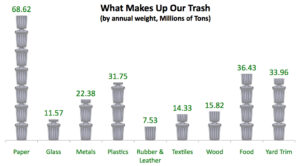Breaking Down Trash – Environmental Fact
Please choose any of the following articles below that interest you. Each article is listed under the month it was written. Articles written in prior months may still have educational interest.
As an abundance of trash is generated every day, more of an effort is being made to collect and recycle as much trash as possible. Several nations worldwide have had growing success in collecting and recycling their trash over the past few years.
Switzerland currently recycles over 50% of its trash with Austria, Germany, Netherlands, and Norway recycling over 40% of their trash. In the United States, the Environmental Protection Agency (EPA) has been monitoring and collecting data on U.S. trash for over 30 years. In its most recent figures, Americans generate about 268 million tons of trash each year and recycle over 91 million tons of it, equivalent to a 35% recycling rate. The EPA estimates that Americans produce an average of 4.48 pounds of trash individually every day. That equates to roughly 1635 pounds of trash each year for every American. The EPA’s objective is to try to find new ways to efficiently and effectively recycle as much of this trash as possible.
The challenges with recycling trash are the many components found in everyday trash and how best to separate them. Known in the trash industry as municipal solid waste (MSW), common everyday trash is comprised of food, waste, grass clippings, sofas, computers, tires, and refrigerators. Fortunately, more and more of these items are being broken down for selective recycling of internal components, both hazardous and non-hazardous.
Most individuals and every type of entity in the country contribute to the trash pile, including individual homes, apartments, businesses, hospitals, and schools. Optimistically, current data from the EPA is telling us that both individuals and businesses are producing less trash than we were 10 years ago.
With over 321 million people producing rubbish in the United States, the feat of recycling nearly 91 million tons of trash is an accomplishment. So where does so much trash go? Most of it ends up in landfills. The number of landfills in the United States has declined over the past few years, yet the average landfill size has increased. On a national basis, landfill capacity is sufficient for current levels of garbage, but it is limited in certain regions of the country.
Source: Environmental Protection Agency

Print Version: Breaking Down Trash Nov 2023


